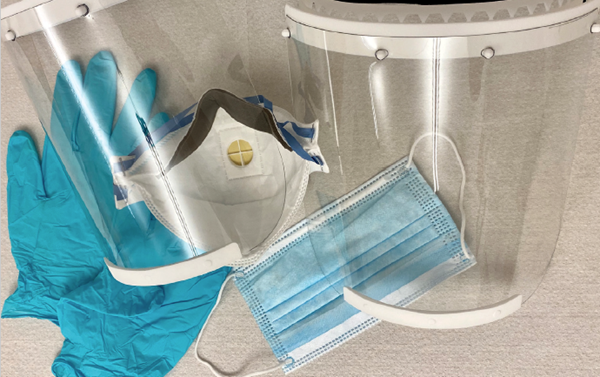On March 17, 2020, my classmates and I at the Georgetown University School of Medicine (GUSOM) were in our homes watching an online lecture while eagerly awaiting an email from our deans determining if our clinical rotations would be delayed due to COVID-19.
The start of clinical training was a moment all of us had looked forward to for months; naturally, it was a tension-filled day. I was sitting in my living room with an open laptop and a head full of questions. Like so many around the globe, I wondered: How much worse was this really going to get? What would happen if I got ill with the virus -- living alone, thousands of miles away from my husband and family? What if the reverse happened? As a student, I wondered how the pandemic would affect my ability to learn clinical medicine, the formative next step in my medical education.
The news, when it came, was not surprising, yet still unsettling: Rotations were (at that time) delayed. The same afternoon, I received a text message from my mentor and friend, Dr. Debjeet Sarkar, an emergency physician in Maryland, who said his team was seeing rising numbers of patients sick with cough, fever, and trouble breathing — all presumed COVID-19 - and thus were burning through personal protective equipment (PPE). His message was succinct: Find a way to increase PPE supplies now.
Dr. Sarkar asked me to mobilize GUSOM medical students to collect PPE from the community (dentists, research labs, pharmaceutical companies, etc.) and get it to hospitals in need. I saw the potential clearly. While medical students would be sidelined from working in the hospitals, we still had invaluable skills to organize, mobilize and problem-solve in the pandemic.
This urgent request shook me out of my state of disbelief. I went from simply reacting to the gravity of the situation to feeling confident we could actually help mitigate this critical problem jeopardizing healthcare workers and the public. I posted on our class Slack channel a request for help. Four fellow third-year students stepped up and we held a teleconference meeting that night. Before we knew it, we were off and running, with more students quickly joining in to help.
We called our project Med Supply Drive (MSD). Quickly the team split up to accomplish different tasks: social media setup, website design, fundraising, emails and texts, and setting up databases to match donated PPE supplies with demand. Within only 2 weeks, we had built a team of 341 volunteers from 37 states, 41 universities, and 66 medical schools.
In the first weeks it was a challenge to balance our educational responsibilities with the breakneck speed of MSD’s growth. But we understood that with any new venture, there is a steep learning curve. For example, our website got flooded with PPE requests that exceeded the donated supply. Our team did their best to match, by location and available local volunteers, where we could drop off supplies quickly because time was critical and shipping was often delayed. To do this efficiently, we set up team leaders in key medical schools that helped ensure smooth delivery of PPE.
We recognized our plan was a stop-gap solution since we could not manufacture PPE. As the weeks went on, it became harder to find supplies and with any money we raised, tracking down sources of PPE was not straightforward. Some sources were selling counterfeit products, while others offered legitimate items that got monopolized by larger groups with more capital.
Even with these barriers, in just 10 days, the team re-distributed:
• 4,700 surgical masks
• 959 N95 masks
• 200 shoe covers
• 24,100 pairs of gloves
• 501 gowns
• 950 hair covers
That total would only grow in the weeks ahead.
Another aspect of the project that proved to be critical was the role social media played in getting our message and plan out to others. We were featured in "Oprah" magazine after one of our team members reached out to a friend who worked there. One of our original members appeared on NPR, another on Fox News, and our social media accounts generated enough buzz that similar organizations emerged, including one in the United Kingdom. The speed of our growth was directly related to the strength of our social media presence; using Instagram, Twitter, Facebook, and our website, we were able to share evidence of our successes, interact and collaborate with other COVID-19 relief organizations, reach potential volunteers and donors, get on the media radar, and inspire others to get involved.
As the organization grew, what came into larger focus was the type of entity we had created: MSD had rapidly built an infrastructure and supply redistribution chain across the United States. This was done by directly engaging and connecting hundreds of smart, conscientious, skilled, and hardworking medical students - and quickly, undergraduate and graduate students and other engaged citizens - for a common purpose. Furthermore, creating and running MSD allowed us to acquire new skills: human resource management, fundraising, negotiating with sellers, partnering with other groups, building a non-profit organization, and becoming savvy with social media and TV appearances -- not typical skills associated with medical students.
At GUSOM all first-years take the P3 (Patients, Population & Policy) longitudinal course. We learn about the social determinants of health that create disparities by race, gender, geography, and wealth (to name a few). Looking back, I can see that P3 laid important groundwork supporting our initiative in forming MSD. The concepts we learned to think critically about in the course contributed to our ability to see beyond our lectures and in real-time, create a novel solution to a key component of a public health crisis. While the pandemic has largely been characterized by conflict and loss, it seems that one silver lining will be the innovative and dynamic leaders that will emerge in medicine.



